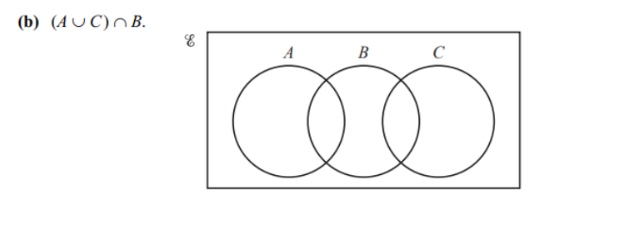(A ∪ C) ∩ B.

Understand the Problem
The question is asking to find the intersection of the union of sets A and C with set B, represented as (A ∪ C) ∩ B. This involves understanding set operations such as union and intersection, which will help identify the elements that are common between these sets.
Answer
The result for $(A ∪ C) ∩ B$ is $\{ b, e \}$.
Answer for screen readers
The elements in $(A ∪ C) ∩ B$ are ${ b, e }$.
Steps to Solve
- Identify the Union of Sets A and C
The first step is to find the union of sets $A$ and $C$. This is represented as $A ∪ C$, which includes all elements that are in set $A$, set $C$, or in both.
- Find the Elements in the Union
Assuming we have the following sets:
- Set $A = { a, b, c }$
- Set $B = { b, d, e }$
- Set $C = { c, e, f }$
The union will be: $$ A ∪ C = { a, b, c, e, f } $$
- Identify the Intersection with Set B
Next, we need to find the intersection of the union $A ∪ C$ with set $B$. This is represented as $(A ∪ C) ∩ B$.
- Calculate the Intersection
Now we combine the results from the union $A ∪ C$ with set $B$: $$ (A ∪ C) ∩ B = { b, e } $$
This includes all elements that are in both the union of sets $A$ and $C$, and set $B$.
The elements in $(A ∪ C) ∩ B$ are ${ b, e }$.
More Information
Finding the union and intersection of sets is a fundamental concept in set theory, which is widely used in mathematics to analyze collections of objects. The intersection shows only the elements that are common between sets.
Tips
- Misunderstanding Union vs Intersection: Ensure to correctly identify when to use union (combining all elements) versus intersection (finding common elements).
- Neglecting Overlapping Elements: Remember to include all unique elements when forming unions and focus on common elements when determining intersections.
AI-generated content may contain errors. Please verify critical information